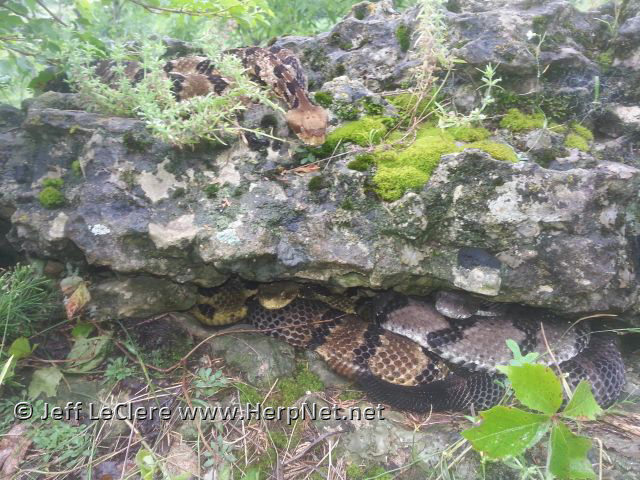Timber Rattlesnake (Crotalus horridus)
by Jeff LeClere
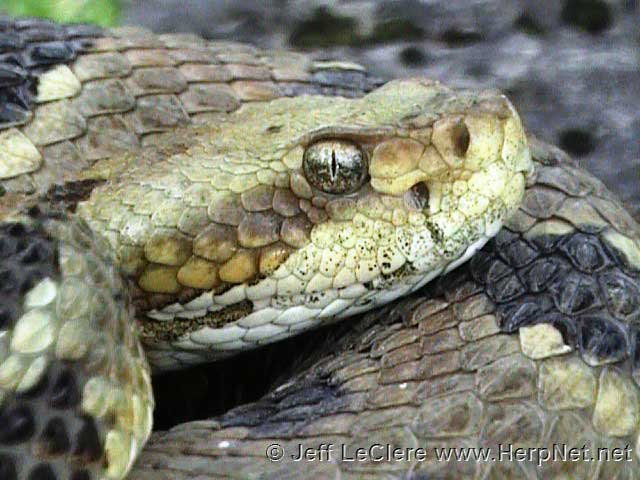
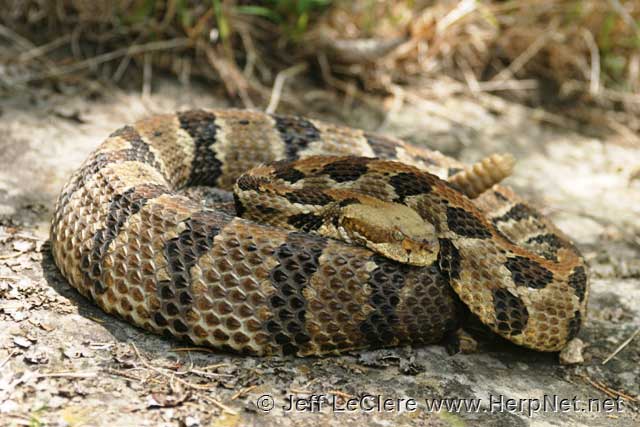
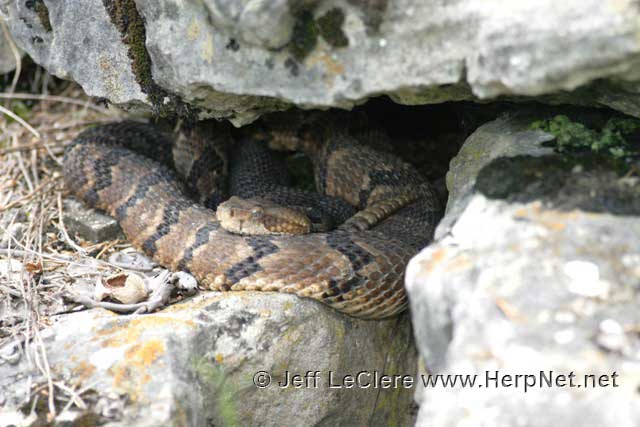
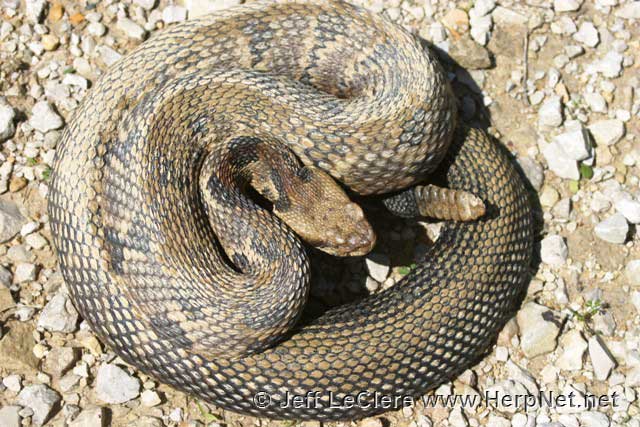
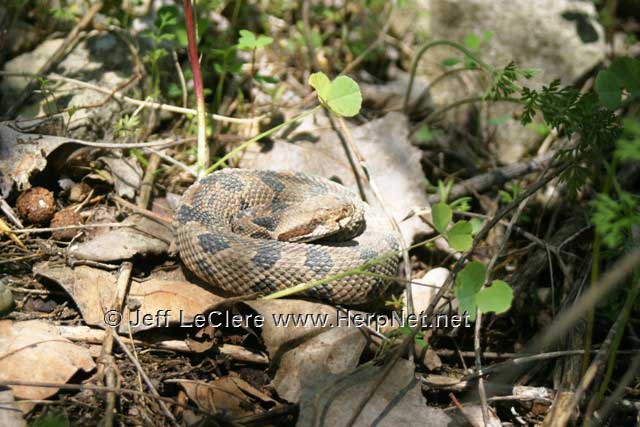
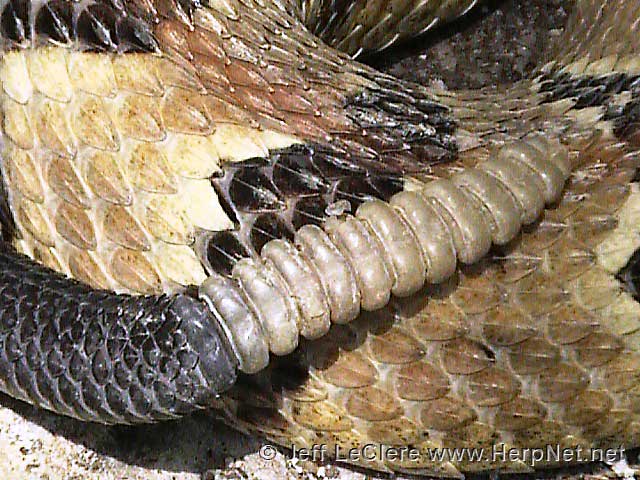
Status
PROTECTED in the following counties: Allamakee, Clayton, Dubuque, Jackson, Winneshiek, Fayette, Delaware, Jones, Henry, Des Moines, Lee, Van Buren, Appanoose, and Madison, except within 50 yards of houses currently occupied by people. Species of Greatest Conservation Need.
Description
Dangerously venomous. This is a large Iowa species that is very heavy bodied and measures from 36 to 60 inches in length; the record is 74 1/2 inches (Conant and Collins, 1991). Timber rattlesnakes have a diamond shaped head which is set off from the relatively thin neck. The pupils of the eyes are elliptical in bright light and there is a heat-sensitive pit between the eye and nostril on both sides of the head.
Ground color may be variable, but a banded pattern is almost always present. Ground color may be yellow, gray, or brown with or without a rusty orange stripe down the center of the back. There are thin black bands or chevrons (not spots) that run across the back for the entire length of the snake. These bands are from 2 – 4 scales wide with a space of about 4 – 6 scales between them and have a light border.
The belly is usually the same color as the dorsal ground color and unmarked, except for some darker stippling on some specimens. The tail is solid black above and below with a tan rattle at the end. This is an excellent field mark; no other patterned Iowa snake has a solid black tail with a tan rattle at the end. The scales are keeled and anal plate is single. The subcaudals are single instead of divided as in all harmless Iowa snakes. Young are patterned the same as the adults and are gray until their first shed. They are 10 – 13 inches in length at birth (Johnson, 1992).
Subspecies
No subspecies are currently recognized.
Range
This species is found throughout most of the southeastern United States and ranges northward from Iowa into Minnesota and Wisconsin via a narrow band along the Mississippi River. In Iowa, they are found along the Mississippi River and in various areas in the southern third of the state. Many of the existing records may unfortunately become invalid due to habitat loss and human interference, activities to which timber rattlesnakes seem particularly sensitive.
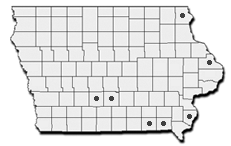

Habitat
Timber rattlesnakes live in the same habitat as eastern milk snakes and prairie ringneck snakes in Iowa; steep bluffs with rocky outcroppings. These snakes favor south and southwest sides of the bluffs and spend most of their time in the sunny open areas surrounded by forest. They overwinter in dens that travel into the sides of the bluff. In southern Iowa, they are found along rocky road cuts that are surrounded by forest. They overwinter communally with other timber rattlesnakes and also other species of snakes such as bullsnakes, eastern milk snakes, western rat snakes, racers, and, less commonly, garter, brown, redbelly, and ringneck snakes.
Habits
Timber rattlesnakes are among the last snakes to emerge from winter dormancy in the spring, and among the first to retire to their winter retreats in the fall. They may bask around their den openings in late April or early May, but they do not move away from their dens until May. Many individuals move to other small, sunny openings of the bluff to spend their summer. Others, particularly males, may travel some distance from the den sites (a few miles) deeper into the surrounding forest or into the lowland meadows and farmland. Still others may spend the entire summer near the den site, especially the gravid females. In the spring and fall, timber rattlesnakes are active during the day, and during the hot summer months, they become nocturnal.
Timber rattlesnakes are surprisingly calm when encountered in the wild. Many will sit motionless hoping that you will not see them. If you do approach too closely, they may slither under a rock or into a crevice without rattling, unlike some other species of rattlesnakes which are more apt to stand their ground. Most of the specimens that I have found failed to sound their rattle, even when hooked, and did not attempt to bite. When rattlesnakes do rattle, they elevate the rattle and black tail high in the air making the rattle extremely obvious. Harmless snakes which vibrate their tails and produce a similar sound, will hold their tails close to the ground. The rattle is comprised of a series of horn-like segments that are loosely attached to one another. When the tail is vibrated, these segments strike against one another to produce a buzzing sound.
When a baby timber rattlesnake is born it has a pre-button on the end of its tail. With the first shed, the pre-button is lost and it is replaced by the first segment. Each time the snake sheds thereafter, another segment is added, producing the rattle. Because the snake receives a new segment with every shed, one cannot determine the snake’s age by the length of its rattle. The rattle is also fragile and it is not uncommon for the snake to have a few of the last segments broken off, to be replaced with more.
Timber rattlesnakes breed in the spring or fall (July or August) and are sexually mature in 7 – 12 years of age. Males may combat with other males. The two snakes intertwine the posterior portion of their bodies together while they raise the anterior half into the air and try to push each other to the ground. The successful male will go on to breed with a female. The females may breed only every 2 – 4 years (3 is the most common interval) and may spend their gestation period near the overwintering dens. They do not eat during this period, but they spend much of their time basking. They are ovoviviparous and give birth to about a half dozen young inside individual membranes. The young are born in August or September and are 10 – 13 inches in length.
A female was found in Jackson County on September 5 with a litter of 11 young. The young were gray, indicating they had not yet shed, and were probably born within the last two days. The female had given birth under a large rock with a depression in both the ground and the rock providing ample room for a small den. The neonates would not wander far from the rock even when the rock was lifted. The farthest distance the neonates traveled was just over a foot. When the rock was replaced and the snakes left alone, the young joined their mother under the rock again. While some authors state that mothers afford no special protection for their young (Klauber 1997; Rubio 1998), recent observations indicate otherwise, at least on some level. The young may remain with the mother until their first shed which may be up to a week after birth. The young are capable of delivering a dangerous, venomous bite at birth. The last fatality recorded from a timber rattlesnake in Iowa was in 1944, and prior to that is believed to be in the 1800s (Bellevue Herald 1944; S. Schroeder personal communication)!
Food
Timber rattlesnakes prey upon small mammals. Mice, chipmunks, ground squirrels, voles, shrews, and squirrels comprise the majority of this snakes’ diet. Birds and birds’ eggs (primarily ground nesters) are consumed at times. Timbers appear to be lie and wait (ambush) predators using many senses to detect prey. They have been observed to lie coiled up next to a fallen log with their head resting on the log. The log acts as a runway for rodents. As a rodent approaches, vibrations traveling through the log alert the snake of a possible meal (Brown and Greenburg, 1992). Eyesight and the heat sensitive pits direct the strike (Oldfield and Moriarty, 1994). The prey is struck and released and the snake follows the prey using scent trailing.
